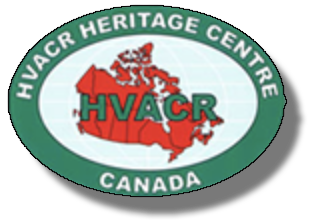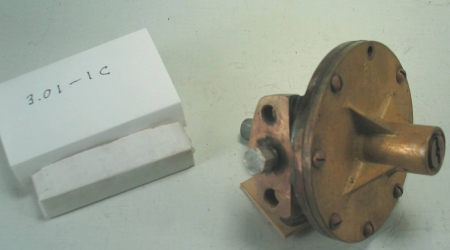Refrigerant Flow Controls – Household
One of a number of later design variants and simplifications of the early automatic, B series, expansion valve by Kelvinator [see also ID #165 & 167]. Handsomely executed in a 5 lb. solid cast brass body with large pressure actuated diaphragm operator, it was engineered for flange mounting for noxious sulphur dioxide, then the low pressure refrigerant of choice, Model B2, Kelvinator, circa 1927.
On of a rare set of three similar valves, demonstrating the array of adaptations and applications conceived by Kelvinator for this refrigerant flow control devices, all emerging from the same basic platform. See ID #3.01-1 A, B, C, See Kevinator manuals of the period for depictions of applications and adaptations.
Heavy, 5 lb. cast brass body; Handsomely embossed with kelvinator logo; Adjustment screw capped and water sealed with knurled brass, screw in cover plate; Heavy brass, threaded access ports for the service of internal mechanism; The valve was conceived by Kelvinator with a spring compensated, 3″ round diaphragm and brass needle seat, suction line mounting flange and pressure adjustment screw, the precursor of much more sophisticated devices to come.
Technical Significance:
A rare specimen of a self-regulating, spring compensated, automatic expansion valve patented by Kelvinator in 1923 and used to maintain cooling units [evaporators], in mechanically cooled refrigerators, at the desired refrigerant pressure.
One of a rare set of three similar valves, demonstrating the vast array of adaptations and applications conceived by Kelvinator for this refrigerant flow control devices, all emerging from the same basic platform, over a period of half a decade or more possibly from about 1922 through to 1929. See ID #3.01-1 A, B, C Kelvinator’s various manual of the period show the many applications and adaptations that would flow from this basic design concept.
This artifact of history tells the many stories of early adoption of this particular fluid flow technology. After a brief flurry of excitement over the use of costly and delicate float operated devices, as a more efficient means of flow control, industry engineers would return to the automatic expansion valve in the early 30’s. But by then the automatic expansion valve would be a smaller and much more precisely calibrated and efficient device. While the automatic expansion valve was less efficient in its effective use of evaporator surface than high and low side float systems [See HHCC Series 3.01 artifacts], it had the advantage of reliability and price, as well as serviceability.
The device demonstrates the manner in which the scientific knowledge, materials and manufacturing methods of the times would come to be used in a refrigerant flow control, popularly appearing in the kitchens of the privileged across the nation.
The artifact is suggestive of the problems faced by the emerging refrigeration service sector in Canada. Kelvinator’s service manual, March 1928 gave full details for cleaning and adjustment on which the homeowner would regularly depend, and in turn the manufacturer, for continued customer satisfaction.
Note the signs of progressive design simplification and economies in size and manufacturing represented here over item ID #165.


